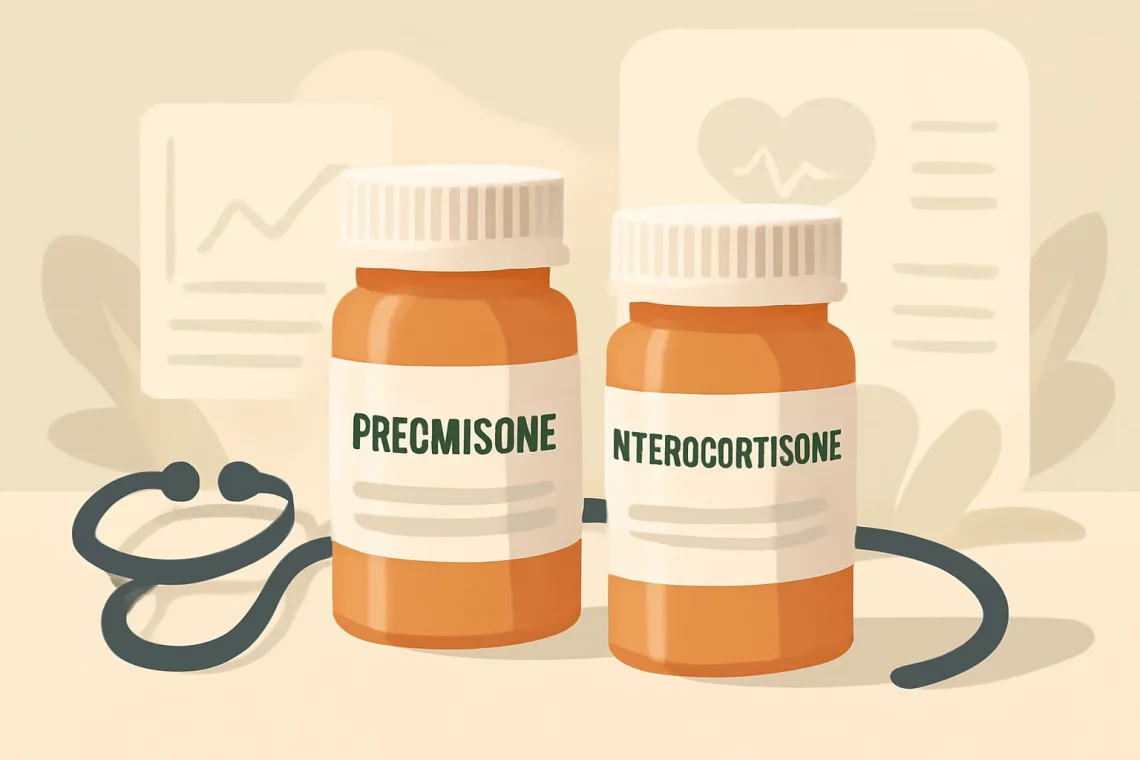
Prednisone vs Hydrocortisone: Key Differences and Uses Explained
Prednisone and hydrocortisone are two corticosteroids that are commonly used in the medical field for their anti-inflammatory and immunosuppressive properties. These medications have been pivotal in treating a variety of conditions, including autoimmune diseases, allergies, and certain cancers. Despite their similarities, there are significant differences between the two that can influence a healthcare provider’s choice in prescribing one over the other.
Corticosteroids, like prednisone and hydrocortisone, are synthetic drugs that mimic the effects of hormones produced by the adrenal glands. They play a crucial role in managing the body’s response to stress and inflammation. Understanding the nuances of these medications is essential for both healthcare professionals and patients alike, as the choice of one over the other can impact treatment efficacy, side effects, and overall patient outcomes.
As we explore the comparative aspects of prednisone and hydrocortisone, we will examine their mechanisms of action, therapeutic uses, side effects, and considerations for use. This comprehensive analysis aims to provide a clearer picture of how these medications function in the body and how they can be effectively utilized in clinical practice.
Mechanism of Action
The mechanism of action for both prednisone and hydrocortisone revolves around their ability to modulate the immune system and reduce inflammation. Corticosteroids work by binding to glucocorticoid receptors in target cells, leading to a cascade of cellular events that ultimately suppress the immune response and decrease inflammation.
Prednisone is a prodrug, meaning it is metabolized in the liver to its active form, prednisolone. Once activated, prednisolone binds to glucocorticoid receptors, influencing gene expression and inhibiting the production of pro-inflammatory cytokines. This action not only reduces inflammation but also impacts the proliferation of immune cells, making it highly effective in treating conditions like rheumatoid arthritis, lupus, and asthma.
On the other hand, hydrocortisone is the natural form of cortisol, which is produced by the adrenal glands. It exerts its effects in a similar manner to prednisone but has a different potency and duration of action. Hydrocortisone is often used in cases where a quick response is needed, such as in acute adrenal insufficiency or severe allergic reactions. Its rapid onset of action makes it a preferred choice in emergency situations.
While both medications share similar mechanisms, the potency differs significantly. Prednisone is generally more potent than hydrocortisone, which means that lower doses of prednisone can achieve similar effects compared to hydrocortisone. This difference in potency can influence the prescribing practices of healthcare providers, as the choice of medication may depend on the severity of the condition being treated.
Therapeutic Uses
Prednisone and hydrocortisone are both utilized in a wide range of therapeutic applications, but the specific uses can vary based on their pharmacological properties.
Prednisone is frequently prescribed for chronic conditions that require long-term management. It is commonly used in the treatment of autoimmune disorders such as rheumatoid arthritis, multiple sclerosis, and inflammatory bowel disease. Its ability to suppress the immune system makes it effective in managing flare-ups and maintaining remission in these conditions. Additionally, prednisone is often used in the treatment of certain cancers, where it helps to reduce inflammation and control symptoms associated with the disease and its treatment.
In contrast, hydrocortisone is often employed for acute conditions, particularly those involving adrenal insufficiency. It is the go-to medication for patients experiencing adrenal crises, where rapid restoration of cortisol levels is critical. Hydrocortisone is also used in the treatment of severe allergic reactions, skin conditions, and as part of replacement therapy for individuals with adrenal disorders.
Moreover, hydrocortisone is often used in topical formulations for dermatological conditions, offering localized treatment with minimal systemic effects. In contrast, prednisone is typically administered orally or intravenously, providing systemic effects that are beneficial for more widespread inflammatory conditions.
The choice between the two medications often depends on the specific condition being treated, the desired speed of response, and the potential side effects associated with long-term use. Understanding the therapeutic uses of each medication allows healthcare providers to tailor treatment plans to individual patient needs.
Side Effects and Considerations
While both prednisone and hydrocortisone are effective in managing various conditions, they are not without potential side effects. Understanding these side effects is crucial for both healthcare providers and patients to ensure safe and effective treatment.
Prednisone can cause a range of side effects, especially when used for extended periods. Common side effects include weight gain, increased appetite, insomnia, and mood changes. More serious effects can include osteoporosis, hypertension, and an increased risk of infections due to immunosuppression. Additionally, long-term use of prednisone necessitates careful monitoring for adrenal suppression, as the body may stop producing cortisol naturally if external sources are provided for too long.
Hydrocortisone, being a natural form of cortisol, tends to have a better side effect profile, especially when used in physiological doses. However, it can still cause side effects such as weight gain, fluid retention, and elevated blood sugar levels, particularly when used in higher doses or for prolonged periods.
When considering the use of either medication, it is essential to evaluate the risk-to-benefit ratio. For patients requiring long-term corticosteroid therapy, lifestyle modifications, such as dietary changes and exercise, may help mitigate some side effects. Additionally, regular monitoring of bone density and blood pressure is advisable for patients on long-term prednisone therapy.
Both medications should be used cautiously in certain populations, including pregnant or breastfeeding women, as well as individuals with pre-existing health conditions such as diabetes or cardiovascular disease. Collaboration between the patient and healthcare provider is essential to develop a comprehensive treatment plan that addresses both the benefits and potential risks associated with corticosteroid therapy.
Conclusion
In summary, prednisone and hydrocortisone are two corticosteroids that play vital roles in managing inflammation and immune responses. While they share similar mechanisms of action, their therapeutic uses, potency, and side effect profiles differ, influencing the decision-making process for healthcare providers. Understanding these differences can help patients and providers navigate treatment options more effectively.
It is crucial to approach corticosteroid therapy with awareness of the associated risks and benefits, as well as the importance of personalized treatment plans. For anyone considering or currently using these medications, it is essential to consult with a healthcare professional for tailored advice and management.
*This article is not intended as medical advice. Always consult your healthcare provider for advice regarding any health-related issues or concerns.*




